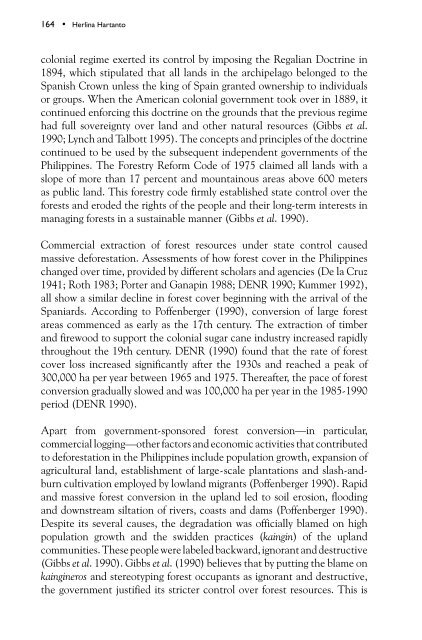Adaptive collaborative management of community forests in Asia ...
Adaptive collaborative management of community forests in Asia ...
Adaptive collaborative management of community forests in Asia ...
Create successful ePaper yourself
Turn your PDF publications into a flip-book with our unique Google optimized e-Paper software.
164 • Herl<strong>in</strong>a Hartanto<br />
colonial regime exerted its control by impos<strong>in</strong>g the Regalian Doctr<strong>in</strong>e <strong>in</strong><br />
1894, which stipulated that all lands <strong>in</strong> the archipelago belonged to the<br />
Spanish Crown unless the k<strong>in</strong>g <strong>of</strong> Spa<strong>in</strong> granted ownership to <strong>in</strong>dividuals<br />
or groups. When the American colonial government took over <strong>in</strong> 1889, it<br />
cont<strong>in</strong>ued enforc<strong>in</strong>g this doctr<strong>in</strong>e on the grounds that the previous regime<br />
had full sovereignty over land and other natural resources (Gibbs et al.<br />
1990; Lynch and Talbott 1995). The concepts and pr<strong>in</strong>ciples <strong>of</strong> the doctr<strong>in</strong>e<br />
cont<strong>in</strong>ued to be used by the subsequent <strong>in</strong>dependent governments <strong>of</strong> the<br />
Philipp<strong>in</strong>es. The Forestry Reform Code <strong>of</strong> 1975 claimed all lands with a<br />
slope <strong>of</strong> more than 17 percent and mounta<strong>in</strong>ous areas above 600 meters<br />
as public land. This forestry code firmly established state control over the<br />
<strong>forests</strong> and eroded the rights <strong>of</strong> the people and their long-term <strong>in</strong>terests <strong>in</strong><br />
manag<strong>in</strong>g <strong>forests</strong> <strong>in</strong> a susta<strong>in</strong>able manner (Gibbs et al. 1990).<br />
Commercial extraction <strong>of</strong> forest resources under state control caused<br />
massive deforestation. Assessments <strong>of</strong> how forest cover <strong>in</strong> the Philipp<strong>in</strong>es<br />
changed over time, provided by different scholars and agencies (De la Cruz<br />
1941; Roth 1983; Porter and Ganap<strong>in</strong> 1988; DENR 1990; Kummer 1992),<br />
all show a similar decl<strong>in</strong>e <strong>in</strong> forest cover beg<strong>in</strong>n<strong>in</strong>g with the arrival <strong>of</strong> the<br />
Spaniards. Accord<strong>in</strong>g to P<strong>of</strong>fenberger (1990), conversion <strong>of</strong> large forest<br />
areas commenced as early as the 17th century. The extraction <strong>of</strong> timber<br />
and firewood to support the colonial sugar cane <strong>in</strong>dustry <strong>in</strong>creased rapidly<br />
throughout the 19th century. DENR (1990) found that the rate <strong>of</strong> forest<br />
cover loss <strong>in</strong>creased significantly after the 1930s and reached a peak <strong>of</strong><br />
300,000 ha per year between 1965 and 1975. Thereafter, the pace <strong>of</strong> forest<br />
conversion gradually slowed and was 100,000 ha per year <strong>in</strong> the 1985-1990<br />
period (DENR 1990).<br />
Apart from government-sponsored forest conversion—<strong>in</strong> particular,<br />
commercial logg<strong>in</strong>g—other factors and economic activities that contributed<br />
to deforestation <strong>in</strong> the Philipp<strong>in</strong>es <strong>in</strong>clude population growth, expansion <strong>of</strong><br />
agricultural land, establishment <strong>of</strong> large-scale plantations and slash-andburn<br />
cultivation employed by lowland migrants (P<strong>of</strong>fenberger 1990). Rapid<br />
and massive forest conversion <strong>in</strong> the upland led to soil erosion, flood<strong>in</strong>g<br />
and downstream siltation <strong>of</strong> rivers, coasts and dams (P<strong>of</strong>fenberger 1990).<br />
Despite its several causes, the degradation was <strong>of</strong>ficially blamed on high<br />
population growth and the swidden practices (ka<strong>in</strong>g<strong>in</strong>) <strong>of</strong> the upland<br />
communities. These people were labeled backward, ignorant and destructive<br />
(Gibbs et al. 1990). Gibbs et al. (1990) believes that by putt<strong>in</strong>g the blame on<br />
ka<strong>in</strong>g<strong>in</strong>eros and stereotyp<strong>in</strong>g forest occupants as ignorant and destructive,<br />
the government justified its stricter control over forest resources. This is
















